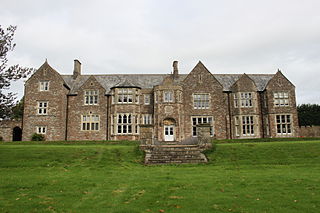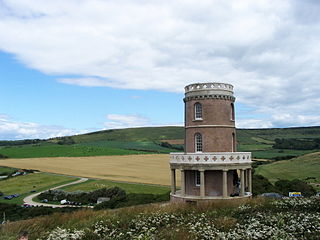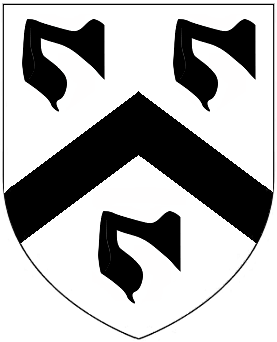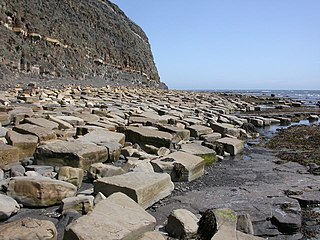Thomas Grey, 1st Marquess of Dorset, 1st Earl of Huntingdon, 7th Baron Ferrers of Groby, was an English nobleman, courtier and the eldest son of Elizabeth Woodville and her first husband Sir John Grey of Groby. Her second marriage to King Edward IV made her Queen of England, thus elevating Grey's status at court and in the realm as the stepson of the King. Through his mother's endeavours, he made two materially advantageous marriages to wealthy heiresses, the King's niece Anne Holland and the King’s cousin, Cecily Bonville, 7th Baroness Harington. By the latter, he had 14 children.

Kimmeridge is a small village and civil parish on the Isle of Purbeck, a peninsula on the English Channel coast in Dorset, England. It is situated about 4.5 miles (7.2 km) south of Wareham and 7 miles (11 km) west of Swanage. In 2013 the estimated population of the civil parish was 90.

The Isle of Purbeck is a peninsula in Dorset, England. It is bordered by water on three sides: the English Channel to the south and east, where steep cliffs fall to the sea; and by the marshy lands of the River Frome and Poole Harbour to the north. Its western boundary is less well defined, with some medieval sources placing it at Flower's Barrow above Worbarrow Bay. John Hutchins, author of The History and Antiquities of the County of Dorset, defined Purbeck's western boundary as the Luckford Lake steam, which runs south from the Frome. According to writer and broadcaster Ralph Wightman, Purbeck "is only an island if you accept the barren heaths between Arish Mell and Wareham as cutting off this corner of Dorset as effectively as the sea." The most southerly point is St Alban's Head.

Swyre Head is the highest point of the Isle of Purbeck in Dorset, on the south coast of England. The hill Swyre Head lies about 2 kilometres (1 mi) southwest of the village Kingston, about 5 kilometres (3 mi) south of Corfe Castle and 8 kilometres (5 mi) west of Swanage.

Hen Cliff is part of the Jurassic Coast near Kimmeridge in the Isle of Purbeck, Dorset, England.

Sutton Court is an English house remodelled by Thomas Henry Wyatt in the 1850s from a manor house built in the 15th and 16th centuries around a 14th-century fortified pele tower and surrounding buildings. The house has been designated as Grade II* listed building.
The High Sheriff of Dorset is an ancient high sheriff title which has been in existence for over one thousand years. Until 1567 the Sheriff of Somerset was also the Sheriff of Dorset.

Clavell Tower, also known as Clavell Folly or the Kimmeridge Tower, is a Grade II listed Tuscan style tower built in 1830. It lies on the Jurassic Coast, on the top of Hen Cliff just east of Kimmeridge Bay in the Isle of Purbeck in Dorset, England. It is now a Landmark Trust property and in August 2006 was moved 25 metres (82 ft) back from the crumbling cliff edge.
William Morgan was a Welsh landowner and politician who sat in the House of Commons of England between 1659 and 1680.

There have been three baronetcies, all in the Baronetage of England, created for members of the Mansel family, which played a major role in the early re-settlement of the Gower Peninsula, in Glamorgan, Wales. Only one creation is extant as of 2008.
Philip Mansel is a historian of courts and cities, and the author of a number of books about the history of France and the Ottoman Empire. He was born in London in 1951 and educated at Eton College, Balliol College, Oxford, and obtained a doctorate at University College London in 1978. He has lived in Paris, Istanbul and Beirut and now lives in London.

Sir Courtenay Cecil Mansel, 13th Baronet was a Welsh landowner and farmer, barrister and Liberal Party politician who later joined the Conservatives.

St Giles House is located at Wimborne St Giles in East Dorset in England, just south of Cranborne Chase. It is the ancestral seat of the Ashley-Cooper family, which is headed by the Earl of Shaftesbury. The estate covers over 5,500 acres (22 km2).
Henry Walter (1785–1859) was an English cleric and antiquary.
John Clavell Mansel-Pleydell (1817–1902), originally John Clavell Mansel, was a Dorset antiquary, known for contributions to geology, botany, and ornithology.

Soughton Hall is a Grade II* listed country house hotel in Sychdyn, Flintshire, Wales. Notable guests that have stayed include Luciano Pavarotti, Michael Jackson and King Juan Carlos I of Spain. William John Bankes inherited Soughton Hall in the 1815.
John Churchill (1657–1709) of Colliton House and Fordington, Dorchester, Dorset, was an English lawyer and Whig politician who sat in the House of Commons briefly from 1708 to 1709.

Kimmeridge Ledges is a set of Kimmeridge clay ledges stretching out in to the sea on the Isle of Purbeck, a peninsula on the English Channel coast in Dorset, England.They are located to the southeast of Kimmeridge Bay and south of the villages of Kimmeridge, on the Smedmore Estate.

Mortons House Hotel in Corfe Castle in Dorset, is a building of historical significance and is Grade II* listed on the National Heritage List for England. It was built in 1590 and was the home of several notable families over the next four centuries; it is now a hotel.

The Mansel family, also known throughout history as Mansell and Maunsell, is a British noble family.












